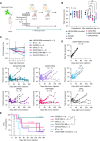A Checkpoint Reversal Receptor Mediates Bipartite Activation and Enhances CAR T-cell Function
- PMID: 39973814
- PMCID: PMC11955954
- DOI: 10.1158/2767-9764.CRC-24-0125
A Checkpoint Reversal Receptor Mediates Bipartite Activation and Enhances CAR T-cell Function
Abstract
Abstract: The efficacy of chimeric antigen receptor T cells (CART) in solid tumors is limited by immune inhibition. In our study, we observed that effector cytokines mediated the upregulation of the PD-L1 immune checkpoint in primary glioblastoma. To offset the PD-L1 inhibitory signal, we engineered PD-1 checkpoint reversal receptors (CPR) with a CD28 or 41BB costimulatory endodomain and coexpressed them with a first-generation or a CD28-containing second-generation HER2-specific CAR (CPR/CART) using bicistronic vectors. We found that bipartite T-cell activation, by CAR-generated signal 1 and CPR costimulation (signal 2), fine-tuned proinflammatory cytokine release and sustained antitumor activity. Whereas both CPR28 and CPR41BB effectively counteracted the PD-1 signal in vitro, CPR41BB, when coexpressed with a first-generation CAR (CARζ/CPR41BB), promoted central memory differentiation following repeat antigenic stimulation. CARζ/CPR41BB T cells formed a robust immune synapse with tumor targets, similar to a 41BB-containing second-generation CART, maintained the favorable metabolic parameters associated with 41BB costimulation, and demonstrated superior antitumor function after adoptive transfer in xenograft models of gioblastoma and metastatic osteosarcoma. Thus, a CPR molecule with 41BB costimulation that curtails PD-1 inhibition and complements CAR signaling to optimize T-cell activation could enhance CART efficacy against solid tumors.
Significance: Enhancing CART function and persistence while balancing immune effector-mediated inflammation is crucial. Using our clinically relevant HER2-CAR platform, we demonstrate that tumor-intrinsic signals like the PD-1/PD-L1 immune checkpoint can be leveraged in CART design to modulate immune synapse and metabolic parameters, improving antitumor function without increasing cytokine production.
©2025 The Authors; Published by the American Association for Cancer Research.
Conflict of interest statement
S.A. Navai reports grants from the NIH and Curing Kids Cancer during the conduct of the study. K. Sanber reports grants from Conquer Cancer, the ASCO Foundation outside the submitted work. A.Z. Gad reports grants from the Cancer Prevention and Research Institute of Texas during the conduct of the study. N. Ahmed is a paid consultant for The Children’s Cancer Hospital of Egypt 57357 in the matters of development, received one-time royalties from Celgene and Cell Medica, consulted in the past for Adaptimmune, and continues to consult for Equillium (pro bono). M. Hegde reports grants from Alex’s Lemonade Stand Foundation, the Stand Up To Cancer/American Association for Cancer Research, Curing Kids Cancer, the V Foundation for Cancer Research, the NIH, the Cancer Prevention and Research Institute of Texas, The Faris Foundation, and Cookies for Kids’ Cancer outside the submitted work; in addition, M. Hegde has a patent to “Method for producing cytotoxic effector memory T cells for CAR T-cell treatment of cancer” pending. K. Sanber, V.S. Salsman, T.T. Byrd, S.K. Joseph, N.Ahmed, and M. Hegde are named inventors on patent applications in the field of CART therapy owned by Baylor College of Medicine. No disclosures were reported by the other authors.
Figures







References
MeSH terms
Substances
Grants and funding
LinkOut - more resources
Full Text Sources
Research Materials
Miscellaneous

